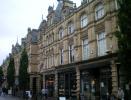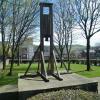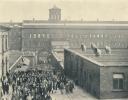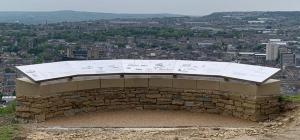The Piece Hall
Halifax's jewel in the crown
_1.jpg)
The Piece Hall is a Grade I listed building. It was built as a cloth hall for handloom weavers to sell the woollen cloth "pieces" they had produced.
The earliest known reference to the new Piece Hall was a handbill dated 19 March 1774, although this no longer survives. The hall was built for "the purpose of depositing and exposing to sale the worsted and woollen goods manufactured in this town and neighbourhood". It was seen that bringing merchants and buyers together in one place would create a more competitive and efficient market and discourage fraudsters. Initially, two sites were proposed, one at Talbot Croft and the other at Cross Field (which was used in 1948 for the construction of the, now demolished,“new” bus station). After consideration, Talbot Croft was chosen and was purchased in September 1774.
It opened on 1 January 1779, with 315 separate rooms arranged around a central open courtyard.
The architect of Piece Hall has never been identified, and there is a lack of documentary evidence surrounding its design and construction; F. A. Leyland cited Thomas Bradley as the most likely architect in 1887, although others have suggested Samuel and John Hope and John Carr.
An 1831 description of Piece Hall says:
The Piece Hall was erected by the manufacturers and is a large quadrangular building of freestone occupying an area of ten thousand square yards with a rustic basement storey and two upper storeys fronted with two interior colonnades which are spacious walks leading to arched rooms where goods in an unfinished state were deposited and exhibited for sale to the merchants every Saturday from ten to twelve o clock. This structure which was completed at an expense of £12,000 and opened on 1 January 1779 unites elegance convenience and security. It contains three hundred and fifteen separate rooms and is proof against fire.
— Samuel Lewis, A Topographical Dictionary of England
The industrial revolution saw a shift away from small producers and traders, with new larger mills in the Halifax area trading directly with merchants and exporters. After years of decline, the Piece Hall was acquired from the trustees in 1868 by Halifax Corporation. They converted it into a wholesale market hall and some of the small rooms were combined to make larger shop units; cellars were created and the south pedestrian gate was enlarged to allow vehicles to enter the courtyard with Iron Gates installed over the entrance, supplied by George Smith of the Sun Foundry, Glasgow for £120. Sheds and latrines were constructed in the courtyard.
In 1971, after the Piece Hall had become unsuitable for a wholesale market, the businesses were dispersed elsewhere throughout the town and demolition of the then two-century-old building was considered. Government grants were made available and the Halifax Corporation received funding to make the building a tourist attraction. The sheds that had been built in the 19th century were demolished and the courtyard landscaped; further, walls were removed from the original rooms to create shops, and a new museum–art gallery was opened on the east side. The new Piece Hall opened on 3 July 1976. The museum–art gallery closed in 1998.
In 2010, the Heritage Lottery Fund awarded Calderdale Council first round funding to restore and redevelop the Piece Hall. The Piece Hall Trust was been set up as a charity responsible for managing the Piece Hall.
The Piece Hall Trust reopened the Piece Hall on 1 August 2017, after a £19 million restoration project which had started in 2014 and overran its intended completion date by a year.
The Piece Hall hosted its first major music event in May 2018 with Father John Misty headlining. There is now a programme of musical events throughout the summer. The Trust stages other events throughout the year, while the former trading rooms provide Restaurants, Bars, Cafes and a wide range of retail outlets.
The Piece Hall was listed on 3 November 1954 and has Grade I listed protection. Reasons for the listing were given as:
· Historic interest: citing the scale and architectural grandeur and its illustration of the wealth of Halifax at the time of its construction.
· Rarity: citing the rarity of surviving purpose built cloth halls.
· Architectural interest: citing its dramatic design, its detailed galleries and courtyard as well as a high degree of craftsmanship and the high quality of materials used
· Architectural layout: citing the courtyard plan but the provision of individual rooms to enable confidentiality in transactions. Despite the combination of some rooms internally the building remains externally unchanged and "visually readable".
Further information can be found at their website https://www.thepiecehall.co.uk
Related pages...
Calderdale Royal Hospital
more The main Hospital for the the town
Shaw Lodge Mills
more A brief history of this icon of the textile industry in the Halifax area

The Shay Stadium
more The home of professional sport in the town

Eureka! The National Children's Museum
more A popular children's museum
The Halifax Building Society
more Headquarters of the eponymous financial institute
_1.jpg)
Wainhouse Tower
more A victorian "Folly"

Stoodley Pike
more A war memorial in the Todmorden area

The Halifax Borough market
more The victorian covered market in the town centre
_1.jpg)
Square Church Spire
more The spire is all that remains of this church

The Halifax Gibbet
more A forerunner of the Guillotine
Halifax Town Hall
more Seat of Local Governance

Halifax Minster
more The centre of worship in Town

Dean Clough
more An industrial powerhouse of the past
_1.jpg)
All Souls Church
more The church of a former model village

Black Dyke Mills
more An icon on the outskirts of Halifax
back to page above this...

The Centenary Viewing Platform at Beacon Hill
back To celebrate 100 years of service to the town of Halifax we have commissioned viewing platform on Beacon Hill overlooking the town. Situated on the Magna Via, an old packhorse route, the walk to the top is worth it.